How To Paint A Flower Bouquet In A Ceramic Vase
Ever wondered how to create a stunning acrylic painting of a dark green vase adorned with a vibrant bouquet of gorgeous flowers? Watershed has got your back. We have complied a step-by-step guide that you can follow to bring this masterpiece to life:
Here Is What You Will Need
Acrylic paints (dark green, a range of floral colours for bouquet like yellows, pinks, reds, purples, oranges etc.; pick your faves )
A good quality canvas
Assorted acrylic brushes (fine, medium, and flat)
A Tray for mixing colors
Water
Cloth for cleaning brushes
Pencil and sharpener for outlining the drawing
Draw a Rough Idea of your Composition:
Use an HB or H pencil to sketch the contours of your vase and the some floral shapes of your bouquet Some example flowers could be tulips, peonies, roses, pansies etc. This will act as a great guide for your painting process and keep things organized.
Painting The Vase:
With acrylics, you can go from lighter to darker shades of colours and darker to lighter. You can start either way but we find it easier to start with the darkest shade of green, in this case, for the vase. Gradually add lighter shades to create depth and dimension; use a lighter shade of the green or you could also experiment with a different highligh colour like yellow ochre to bring some drama into the compostion. You can either use a dry brush technique for blending, adding texture and highlights or you can use wet-on-wet technique to create some interesting patterns in your painting and let colours flow into each other naturally.
Painting the Flowers:
Begin with the largest flowers and work towards smaller details. You can be an impressionist and add small patches of dots to create an appearance of flowers. You can mix colors to achieve the right shades for petals and leaves. You may even reference a real bouquet to get some ideas. Pay attention to light and shadow to make your bouquet pop.
Final Touches:
Add finer details like reflections on the vase or individual petals. You can go into extra details if you like or you can leave it somewhat raw for a different vibe. Step back occasionally to assess your painting and make adjustments. Allow your painting to dry completely. Sign your artwork and get it framed for display or hang as is.

